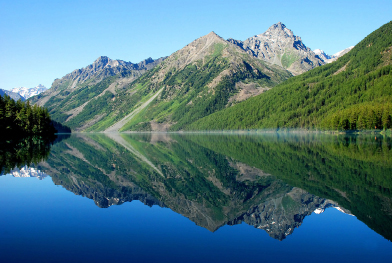Module 5
1. Module 5
1.15. Page 5
Module 5: Angles
Lesson Summary

© Tatiana Grozetskaya/shutterstock
Many photographs and paintings of alpine scenery involve reflections in the mirror surfaces of mountain lakes. The angles formed by the mountains and their reflections are bisected at the shoreline. This lesson involved similar relationships between the arms of angles and the bisectors of those angles. Bisectors behave like mirrors, reflecting each arm into the other.
In this lesson you explored these questions:
-
What does it mean to bisect an angle?
-
How are different techniques used to bisect angles?
Check your level of understanding of the materials covered in this lesson by completing “Lesson 3 Traffic Lights.” If you select an amber or red traffic light in the multimedia piece, you will receive information about additional work you can complete to improve your understanding of the topics. Complete the suggested work before you proceed to the Lesson 3 Assignment. If you experience difficulty, contact your teacher before starting the Lesson 3 Assignment.
You also investigated the definition and construction of angle bisectors. To construct these angles, you used paper folding, compasses and a straightedge, and squares from a geometry set.
 Assignment
Assignment
Retrieve the Lesson 3 Assignment Booklet you saved in your course folder at the start of this lesson. Complete the Assignment. Resave your Assignment Booklet in your course folder and submit a copy to your teacher for assessment.
Unit 3 Project
If you are a scrapbooker or are interested in design, you have most likely needed to find the middle of an angle and have been using your bisecting skills without even realizing it. Examine your Unit 3 Project topic. Where might an understanding of bisectors be useful? Can you visualize anywhere that an angle might be bisected? Save any notes and sketches for use in your Unit 3 Project.